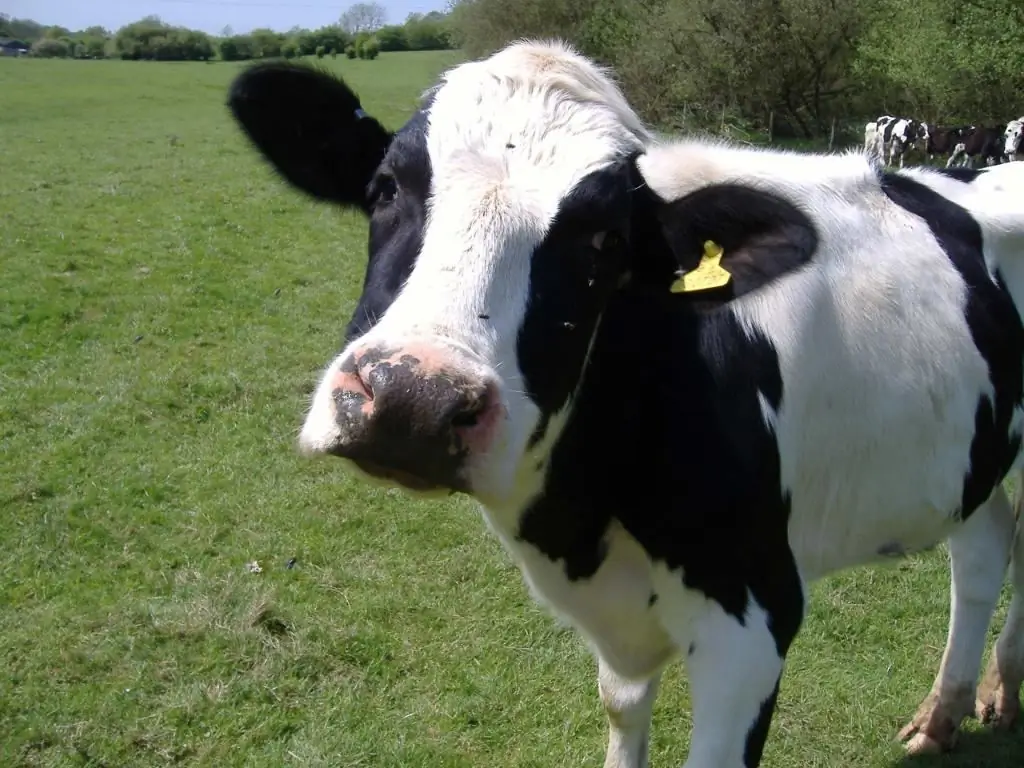2026 Author: Howard Calhoun | [email protected]. Last modified: 2025-01-24 13:10:45
When caring for artiodactyl pets, the question of what a cow drinks is important. Burenka is not suitable for any liquid. It happens that the animal refuses water at all. This can affect the well-being of the cow in the most unfavorable way. In addition, the process of milk production requires the obligatory presence of liquid in the cow's body.
The amount of liquid consumed directly depends on the age of the cow, its breed, living conditions. The nuances of proper care will be discussed in the article.
How to count?
The answer to the question of what the cow drinks is, of course, water. But its amount will depend on several parameters that were named earlier. For example, dairy individuals consume approximately 5 liters per kilogram of feed daily. That is, with a daily intake of 8 kg of feed, 40 liters of water will be needed. In this case, the amount of milk received will be up to 40 liters per day. However, the body of the cow itself also requires nutrient fluid, soshe is given succulent food or additional water poured into the drinker.
In the summer, when a cow is out on the pasture and eating grass, it is difficult to accurately calculate how much liquid she consumes, but experts say that this amount is 20-40 liters per day. For meat breeds, the amount of liquid is 3-4 liters per kilogram of feed.
So, we found out that a cow drinks at least 40 liters a day, but there are individuals that consume up to 100-130 liters, and this is quite normal.

No water
If the animal does not drink water, the reasons for this may be:
- cold liquid;
- access to drinker difficult;
- water contains unpleasant impurities;
- stomach full or foreign objects in it.
The last case requires a mandatory visit to the veterinarian.
Liquid containers
When keeping animals, special drinkers for cows are used. In large farms, a tiered watering system is used. In the drinkers there is always the required amount of liquid supplied to the animal according to the principle of a communicating vessel. But the cow should have free access to water anyway.

If the animal is kept loose, group drinkers are used. They can be placed directly on the pasture, more conveniently on a pedestal. Heated containers are also used, the optimal size of the bowl is 90 x 40 x 40 cm.
Feeding Features
So, we figured out what the cow drinks. Of course it's water. However, bran, wheat, barley and other cereals can be added to it. In this way, some types of feed are bred, especially solid ones. I wonder what the cow eats?
All food experts divide into several groups:
- vegetable (hay, chaff, straw, gourds, grass, silage, cereals, root crops);
- of animal origin (meat and bone meal, whey, feed fat);
- compound feed (they are mixtures of various components);
- vitamins (found in feed and specially added in the form of drugs).

So, now some nuances of keeping cows have become clear. Undoubtedly, this information will be useful to livestock breeders when caring for cows.
Recommended:
Cow: keeping at home, methods and technologies

Cows are kept in two ways: tethered and loose. In the household, the loose method is the most popular, giving the animal a certain freedom of movement, which has a positive effect on the he alth of the cow and the milk received from it
Forage cow. What to feed a cow? Average daily milk yield per cow

Forage is a feed of plant origin, which is used to feed farm animals. Previously, this word was used to feed horses, and later they began to use it for large and small cattle. As a result, the expression "fodder cow" appeared. Such animals allow you to get more profit
Running a cow before calving: basic rules. When to stop milking a cow before calving

The start of a cow before calving must, of course, be done correctly. Otherwise, the cow calf may be born unhe althy. In addition, the cow herself, after giving birth, with an incorrect start or its absence, will give little milk
Cow cow: concept, definition, main differences, performance improvement and economic damage

The presence of dry cows in the herd causes a decrease in the profitability of the farm. The farmer can bear huge losses due to infertility of heifers. In order to eliminate the barrenness of cows on the farm, it is necessary first of all to properly develop the diet of animals and provide them with good living conditions
What will happen if the cow is not milked. Why does the cow not give milk

Today, many people are returning to subsistence farming and have cattle to have the freshest and most natural food on their table. But not all of them know how to properly care for animals. What happens if the cow is not milked? How many times does it need to be milked? And why does the horned nurse lose her milk?

